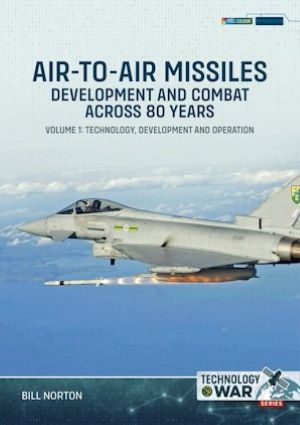Air to Air Missiles, Development and Combat across 80 Years, Volume 1: Technology, Development and Operation
Air-to-air missiles (AAMs) are a part of almost every tactical aircraft and some helicopters these days. If you’re anything like me, they tend to be part of the finishing bits we grind through at the end of a build. Perhaps a deeper understanding of these weapons and their integral connection to the aircraft we build will make finishing those missiles a bit easier. This is the first of six volumes dedicated to the history of air-to-air missiles (AAM). In this first volume, the author, Bill Norton, a former Air Force officer and flight test engineer with 40 years of experience, introduces us to a comprehensive history—in six volumes of these weapons.
Four sections comprise this book: Introduction, Missile development, Missile Elements and Operational Fundamentals. Mr. Norton has taken a very technical subject and written this book in a way that’s easy for non-engineers to understand. Various diagrams in the book are used to explain concepts in missile design and what the missile “sees” when it is tracking targets. There are numerous illustrations and photos to help explain the text, but no missile systems are covered in detail. For that, you will have to look at subsequent volumes.
What becomes clear is just how far these systems have come with the development of solid-state electronics and computers. In fact, these systems have support networks as complicated as the aircraft that carry them. There are some nice color side view drawings in the center pages of this volume. These represent aircraft of several nations and the missile systems associated with them. As a model reference, this book has value mainly in the photos and drawings. In fairness to the author, this book was not written for modelers, but more for the historian who wants to understand these weapons and their development.
The subsequent five volumes go into detail about various AAM missile generations, including their creation and deployment. While those are certainly more of what we modelers look for, you cannot fully know a subject until the basics are learned. This book provides the foundation for a subject that is more interesting than you might think.
I would recommend this book for learning the history of AAM development. Thanks to Casemate for the sample volume, and to IPMS/USA for sharing it with me.





Comments
Add new comment
This site is protected by reCAPTCHA and the Google Privacy Policy and Terms of Service apply.
Similar Reviews